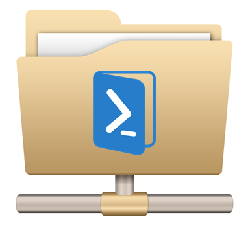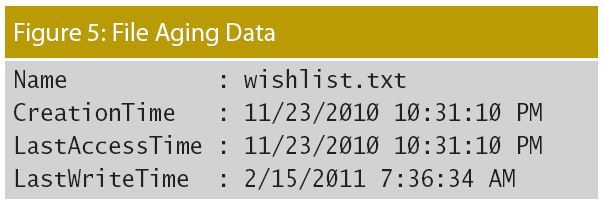Get Network Folder Reports Using PowerShell
- Transfer
- Tutorial
 Jeffrey Hicks has published another PowerShell article this time around managing file servers. We decided to break it into two parts: building reports on the file server and directly managing the file spheres. In the first part we will consider reports.
Jeffrey Hicks has published another PowerShell article this time around managing file servers. We decided to break it into two parts: building reports on the file server and directly managing the file spheres. In the first part we will consider reports. The following questions will be considered in the post:
- How to list all network folders on a computer (computers)
- We create reports on the sizes of network folders
- Determine file owners
- We find the date of creation of the files, we identify the "old" files and files created over a certain period of time)
So, under the cut you will find the translation of the article File Server Management with Windows PowerShell .
Get all network folders
Let's start by defining what is shared. The task is simple: we simply query the Win32_Share class to use Windows Management Instrumentation (WMI). You do not even need to log in to the file server. You can run this command from anywhere.
Get-WmiObject -class -Win32_Share -computername chi-fp01
Instead of chi-fp01 we will indicate the name of the computer we are interested in.
By running this command you will receive all network folders, including printers (if any). But since we are talking about file balls, let's limit the request. All instances of Win32_Share have a Type property, as shown in Table 1.

Add a filter to the original command:
Get-WmiObject -class -Win32_Share -computername chi-fp01 –filter "Type=0"
Thus, we display only the necessary information.

But if you are also looking for hidden folders - those that end with a dollar sign ($) - you will have to slightly rewrite the filter:
Get-WmiObject -Class win32_share -computername chi-fp01 –filter "Type=0 AND name like '%$'"
In WMI, the percent sign (%) is used instead of the wildcard. List all folders except those that are hidden a little harder.
Get-WmiObject -Class win32_share -computername chi-fp01–filter "type=0 AND name like '%[^$]'"
The command displays all Win32_Share objects for which the Type property is 0 and the name does not end with $.
Get the size of the network folder
Quite often, information is needed on how much space file balls occupy. We use Get-ChildItem , or its abbreviation dir , and pass the results to Measure-Object :
dir c:\shares\public -recurse | where {-Not $_.PSIsContainer}| Measure-Object -Property length -Sum -Minimum -Maximum
As a result, you will get information about the total number of objects, size in bytes, smallest and largest file sizes. In the previous command, I applied a filter. In PowerShell 3.0, the same can be done easier, but the command I used works both v2.0 and 3.0. It is best run locally. The code in Example 1 combines this command with our WMI technique to get a report on the size of high-level folders.
Example 1: Report on the size of high-level network folders
$share=Get-WmiObject -Class Win32_Share -ComputerName
CHI-FP01 -filter "name='Sales'"
$sb={
Param ($path)
dir $path | where {$_.PSIscontainer} |
foreach {
$stats=dir $_.Fullname -recurse -errorAction
"SilentlyContinue" | where {-NOT $_.PSIscontainer} |
Measure-object -Property Length -sum
New-Object -TypeName PSObject -Property @{
Computername=$env:Computername
Path=$_.Name
Fullname=$_.Fullname
SizeKB=[math]::Round(($stats.sum/1KB),2)
NumberFiles=$stats.count
} #property
} #foreach
} #sb
$results=Invoke-Command -ScriptBlock $sb -ComputerName
$share.__SERVER -ArgumentList @($share.path)
-HideComputerName
You can format or process $ results as you wish. Need a digestible table? Just use the following command:
$results | Format-Table Computername,Fullname,SizeKB,NumberFiles -autosize

Thus, it is possible to make a full report on the use of all folders on the file server. Save time by using Example 2.
Example 2: Report on file ball usage
$sb={
#Get the file shares locally.
$shares=Get-WmiObject -Class Win32_Share -filter "type=0"
foreach ($share in $shares) {
#Suppress any access denied error messages.
Write-Host "Measuring $($share.path)" -ForegroundColor Green
$stats=dir $share.path -Recurse -ErrorAction SilentlyContinue |
Where {-Not $_.PSIscontainer} |
Measure-Object -Property Length -Sum
$hash=@{
Computername=$env:Computername
Path=$share.path
Share=$share.Name
SizeKB=[math]::Round(($stats.sum/1KB),2)
Files=$stats.count
}
#Write a custom object to the pipeline for each share.
New-Object -TypeName PSObject -Property $hash
} #foreach $share
}#sb
$results = Invoke-Command -ScriptBlock $sb -ComputerName
CHI-FP01 -HideComputerName
And again, I will slightly format the table.
$results | sort SizeKB –Descending | Select Computername,Share,SizeKB,Files | ft -auto

Get files by owner
We move on - find the owners of the files. If you use quotas, you’ll probably get reports. Otherwise, all you need to do is extract the ACL of the file, which includes the owner, and aggregate the results. It’s best to add the file owner as a custom property
$data=dir | where {-not $_.PSIsContainer} | select name, @{Name="Owner";Expression={(Get-ACL $_.fullname).Owner}}, length
We can group by property the new owner and then process the new object.
$data | group owner | Select Name,Count,@{Name="Size";Expression={($_.Group | Measure-Object -Property Length -sum).Sum}}
A couple of efforts and you can apply the same approach to the file ball, as indicated in the code in Example 3.
Example 3: Group file balls by owner
$sb={
Param($path)
$data=dir $path |
where {-not $_.PSIsContainer} |
select name, @{Name="Owner";Expression=
{(Get-ACL $_.fullname).Owner}},length
$data | group -property owner |
Select @{Name="Computername";Expression={$env:computername}},
@{Name="Path";Expression={$path}},Name,Count,@{Name=
"Size";Expression={
($_.Group | Measure-Object -Property Length -sum).Sum}}
} #sb
<#
Run the command remotely and suppress the RunspaceID since we
don't really need it.
#>
Invoke-Command -ScriptBlock $sb -ComputerName CHI-FP01
-ArgumentList @("c:\shares\public") -HideComputerName |
Select * -ExcludeProperty RunspaceID
I should also point out that there may be problems: with files whose name is more than 260 characters or contains unusual characters, especially if you are trying to run Get-ACL. In PowerShell 3.0, this cmdlet has the -LiteralPath parameter , which helps solve the above problems.
We will display the readable table again.
$data | Sort Size | ft -auto

We receive files by date of creation
The last reporting technique I want to demonstrate is creating a report with the most recently created files. In fact, we are creating a collection of objects that we can use in several ways. You may want to use objects or delete or move files, or you may want to build a report that you can send to management. Always create PowerShell commands so that you can use them later.
Determining the age of a file is not so simple. In PowerShell, a file object (an object of type file) has several properties that you might want to use. For example, the command:
get-item c:\work\wishlist.txt | Format-List Name,*time
gives the conclusion presented in the screenshot below.

Personally, I think it's better to use LastWriteTime , which indicates when the file was last accessed. I have encountered situations where LastAccessTime was updated through third-party programs, for example, an antivirus, which in itself does not mean the truth. And LastAccessTime has been deactivated since Windows Vista, although you can enable it. You also need to be careful because these values may vary depending on whether you are copying or moving files between disks. But you can solve it yourself. Using this file as an example, we can get PowerShell to tell us how old the file is. See example 4.
Example 4. Determining the age of files
PS C:\work> get-item wishlist.txt | format-list name,
CreationTime,LastWriteTime,
>> @{Name="Age";Expression={(Get-Date)-$_.LastWriteTime}},
>> @{Name="Days";Expression={((Get-Date)
-$_.LastWriteTime).TotalDays}}
>>
Name : wishlist.txt
CreationTime : 11/23/2010 10:31:10 PM
LastWriteTime : 2/15/2011 7:36:34 AM
Age : 511.06:42:17.4251748
Days : 511.279372271039
The Age property is a TimeSpan object , and the Days property is simply the TotalDays property of this object. But since we can do this for one file, we can do for others. Let's take a look at my shared folder and find all the files that have not changed in the last 400 days.
dir c:\shares\public -recurse | Select Fullname,CreationTime,LastWriteTime,
@{Name="Age";Expression={(Get-Date)-$_.LastWriteTime}},
@{Name="Days";Expression={[int]((Get-Date) -$_.LastWriteTime).TotalDays}},
@{Name="Owner";Expression={(Get-ACL $_.fullname).Owner}} | Where {$_.Days -ge 400} | Sort Days -Descending
I will go further and also include the owner of the file. The screenshot below shows the results from running this code in a remote session on my file server.

I can save these results to a variable and use them at any time. Since I have the full file name, transferring to another command, for example, Remove-Item, is not difficult.
One of my favorite techniques is to determine how many files were changed in a year.
dir c:\shares\sales -recurse | Select Fullname,LastWriteTime,
@{Name="Age";Expression={(Get-Date)-$_.LastWriteTime}},
@{Name="Year";Expression={$_.LastWriteTime.Year}} | Group-Object Year | Sort Name
As you can see in the screenshot, everything looks combed. Need details? You can analyze the Group property , which is a collection of files.

It is useful to know how many files have not changed in 30, 90 or 180 days. Unfortunately, there is no easy way to use Group-Object for this, so I need to “go the other way”; see example 5.
Example 5: Defining the period of change of files
$path="c:\scripts"
#Get some other properties in case we want to further
#break down each bucket.
$files=dir $path -recurse |
Select Fullname,CreationTime,LastWriteTime,Length,
@{Name="Age";Expression={(Get-Date)-$_.LastWriteTime}},
@{Name="Days";Expression={[int]((Get-Date)
-$_.LastWriteTime).TotalDays}}
$hash=@{
Path=$path
Over= ($files | Where {$_.Days -gt 365} | Measure-Object).Count
'365Days'= ($files | Where {$_.Days -gt 180 -AND
$_.Days -le 365} | Measure-Object).Count
'180Days'= ($files | Where {$_.Days -gt 90 -AND
$_.Days -le 180} | Measure-Object).Count
'90Days'= ($files | Where {$_.Days -gt 30 -AND
$_.Days -le 90} | Measure-Object).Count
'30Days'= ($files | Where {$_.Days -gt 7 -AND
$_.Days -le 30} | Measure-Object).Count
'7Days'= ($files | Where {$_.Days -gt 0 -AND
$_.Days -le 7} | Measure-Object).Count
}
New-Object -TypeName PSObject -Property $hash |
Select Path,Over,365Days,180Days,90Days,30Days,7Days
The figure below shows the result when I ran this code for a folder with my scripts, which, as I know, has a decent age distribution. My code does not include actual files, but it would be too difficult to modify my example.

The post is based on the first part of the article File Server Management with Windows PowerShell .
Bonus:
By the way, about how to find files using PowerShell and WMI, Jeffrey Hicks writes on his blog (part 1 and 2 ).
Only registered users can participate in the survey. Please come in.
The second part of the article addresses the creation and deletion of a file ball and the delegation of access rights to them. Would her translation be interesting?
- 93.4% Yes 129
- 6.5% No 9
